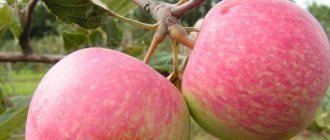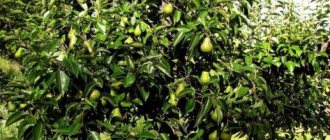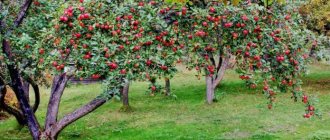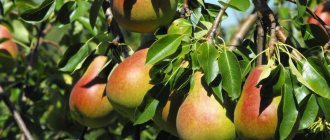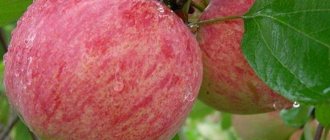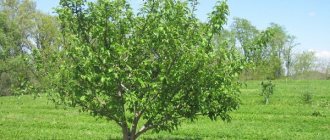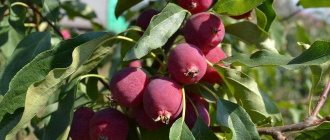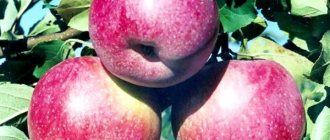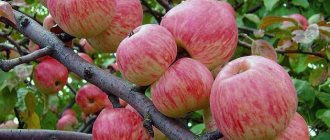Apple trees on the site are an obligatory guest. They produce tasty and healthy fruits, and you can enjoy them throughout the year. A large selection of varieties allows you to choose the one that suits your taste. The Antonovka apple tree is practically the ancestor of many varieties. Its age is more than a hundred years old.
Apple tree Antonovka.
Description of the Antonovka apple tree
Under the general name Antonovka, an entire variety type is united - a group of varieties with similar characteristics. According to various estimates, it can include from 5 to 17 varieties; 7 varieties or synonyms of Antonovka vulgaris are registered in the database of the Federal State Institution “State Commission of the Russian Federation for Testing and Protection of Breeding Achievements”.
The main characteristics of the variety are shown in the table below.
| Parameter | Meaning |
| Plant type | Deciduous tree |
| Mature tree height | Up to 10 m |
| Crown | Spreading, raised, irregular oval or spherical shape |
| Escapes | Green when young, later brown, geniculate |
| Leaves | Rich green color, ovoid, leaf blade wrinkled, leaf edge serrated |
| Flowers | Saucer-shaped, large, white, sometimes with a pinkish tint |
| Flowering time | Beginning of May |
| Self-fertility | Self-sterile variety. To obtain a harvest, apple tree varieties such as Pepin Saffron, Autumn Striped, Anise and others are planted nearby. |
| Precociousness | Low, the first harvest appears no earlier than 5-8 years from the moment of planting |
| Productivity | High, but irregular. By 10-12 years it can reach up to 200 kg per tree; in good weather conditions it can be 1.5 or even 2 times higher. With age, the harvest becomes periodic |
| Fruit | Round in shape, yellow with a green tint. The peel is dense, glossy. Average weight 130-150 g, can reach up to 300 g |
| Classification by ripening period | Late-ripening (early winter) variety, ripening time - second or third ten days of September |
| Keeping quality and transportability | Very high. The further north the growing region, the better the apples are stored. Stable shelf life 3-4, sometimes up to 6 months |
| Taste qualities | The pulp is sweet and sour, juicy. As storage progresses, the taste improves, becoming more pronounced and sweet. |
| Resistance to diseases and pests | Average. May be affected by common scab. The most common pests are aphids, codling moths |
| Winter hardiness | High |
Landing algorithm
The Antonovka apple tree, description of the variety, photos, reviews of which indicate the high winter hardiness of the crop, at the seedling stage it is sensitive to frost, like other garden plants. Planting in the ground is carried out in the fall (2 months before frost) only in warm climates or on chernozem soils.
Spring work (before the leaves appear) will protect the Antonovka seedling from freezing and will give it time to take root and get stronger for the next winter.
Sequence of work:
- When laying planting holes, leave at least 4 meters between them. An adult Antonovka has a wide crown and does not tolerate thickening.
- A stake is attached to the center of each planting to support the plant.
- When adding mineral fertilizers to the soil mixture, make sure that the roots do not come into direct contact with them. Sprinkle soil without additives onto the mound in the center.
- The seedling is placed on a hill in the hole, so that the root collar is slightly higher than the edges (approximately 10 cm).
- The roots are straightened and they begin to be sprinkled with regular garden soil, and then a soil mixture with fertilizers.
- Each layer is carefully compacted.
After filling the hole, the seedlings are watered abundantly, adding at least 20 liters per tree. They wait until the soil settles and tie the plants to the stakes, running a figure-of-eight twine between the trunk and the support. After all manipulations, the grafting site should remain above the ground.
After a few hours, you should check the position of the seedling, and the soil can be generously mulched with humus, peat chips or sawdust.
Varieties of Antonovka apple tree
It is believed that the Antonovka common apple tree variety, the description of which, photos and reviews are presented below, arose as a result of cross-pollination of wild varieties of apple trees. In some sources it is indicated as a variety of folk selection. The first mention of this apple variety was found in scientific literature in 1848. The exact origin of Antonovka is unknown; some foreign sources indicate this type of apple tree as wild. Therefore, the classification of varieties included in this variety type is very conditional.
Often, the same variety, depending on the place of growth, has different properties, as a result of which different sources provide different numbers of Antonovka varieties. For example, in M. V. Rytov’s book “Russian Apples” 17 species of this variety are described, while I. V. Michurin identified only 5 varieties of Antonovka, considering other varieties a mutation under the influence of local conditions.
Currently, the following varieties are included in the Antonovka variety:
- White.
- Gray.
- Onion.
- Dessert.
- Ribbed.
- Golden.
- One and a half pounds.
- Striped.
- Steppe.
- Ordinary.
- Dessert.
In the photo below are Antonovka apples
Apple tree Antonovka common
The Antonovka common apple tree, a description and photo of which is presented below, makes up the main part of the variety. In the literature, this variety of apples is found under such names as Antonovka Kurskaya, Antonovka simple, Antonovka glass, Antonovskoe apple, Wax yellow, Dukhovoe, Krasnoglazovskoe. All these names are synonyms. This is a winter-hardy late-ripening variety that reaches technical ripeness in September, and in hot summers - in early October. An adult tree reaches a height of 5-8 m. The crown grows rapidly upward only in the first years, and over time it becomes rounded and spreading. After planting, it begins to bear fruit in 7-8 years. Fruiting of young apple trees is regular, later it becomes cyclical.
In young apple trees, the weight of the fruit can reach up to 300 g, but with age the average values decrease and stabilize at around 130-150 g. The total yield is 200-300 kg per tree, in especially favorable years it can reach 1 ton. The color of a ripe apple is greenish-green. yellow; as storage progresses, the green tint disappears completely. The funnel has a characteristic “rust” appearance. The shape of the fruit is round, the lower part is slightly narrowed. The pulp is dense, juicy, yellowish in color, the peel is dense, glossy.
The Antonovka common apple tree variety has excellent keeping quality; the fruits do not lose their marketable properties for 3-4 months. In the old days, apples of this variety were widely used for soaking; now they are processed into jam, jams, juices, and also consumed fresh.
Apple tree Antonovka Dessert
The description of the Antonovka Dessertnaya apple tree variety can begin with the fact that it is the result of crossing the Antonovka ordinary and Pepin Saffron varieties. As a result, it has reduced winter hardiness, but a sweeter taste. It is grown mainly in regions located south of Moscow. In the northern and eastern regions, beyond the Urals, growing this variety is possible only on dwarf frost-resistant rootstocks.
The height of an adult apple tree of the Antonovka dessert variety is usually 5-6 m, the crown is round and spherical. The leaves are oval, bright green, slightly wrinkled. The flowers are large, white with a pink tint. The fruits are round, weighing about 200 g. The color of the apples is greenish-cream, with a characteristic striped-mottled blush. The pulp is juicy, greenish-yellow in color, has an excellent taste and strong aroma. Apples are harvested in September, but they reach full ripeness only after a month.
The yield of the Antonovka dessert apple tree variety highly depends on weather conditions and can range from 50 to 150 kg per tree. Fresh fruits can be stored for up to 5 months; in addition, they are processed into jam and marmalade.
Apple tree Antonovka Golden
The Antonovka Zolotaya apple tree variety is a medium-sized tree 5-6 m high with a wide spreading crown. It has good winter hardiness, so it can be grown in many regions of the country. Blooms in early May. The variety is mid-season; apples reach technical ripeness in mid-August. A ripe fruit usually weighs about 250 g. The color of apples is yellow with a green tint. The aroma is strong, rich, the taste is sweeter than that of ordinary Antonovka.
The average yield of Antonovka Zolotoy is 250 kg per tree. The negative side of the variety is its late entry into fruiting (at 6, sometimes 7 years), as well as its tendency to shed. Unlike the common Antonovka, the Golden one suffers from scab much less often. The keeping quality and transportability of the fruits are good, but their fresh storage juice is significantly less than that of late varieties of apple trees. Antonovka Zolotaya is a universal purpose variety.
Apple tree Antonovka One and a half pound
This Antonovka variety owes its name “One and a half Pound” to its fruits, which reach a weight of 600 g. Its appearance is attributed to I.V. Michurin, and the basis of the selection was the Antonovka Mogilevskaya Belaya variety. In addition to the significant weight of the fruit, Antonovka Polutora Poundovaya has excellent frost resistance, so it is grown in a wide variety of regions. The apple tree is quite tall, 6-7 m, with a wide, rounded crown. It usually begins to bear fruit at 6-8 years. Harvest ripening time is early September.
The fruits of Antonovka one and a half pound weigh on average 250-300 g, larger specimens are found on young trees. The productivity of the variety is high. The apples are white with a greenish tint, there is no top coloring. The keeping quality and transportability of the fruits are low, but due to their unique aroma, excellent taste and size, they are ideal for industrial processing.
Features of the plant and fruiting
The tree is vigorous and can reach a height of 8 meters. The natural shape of the crown is raised, in the form of an irregular oval, and becomes spreading with age. The main branches are covered with brown bark and are well overgrown with branched ringlets. About 50-60% of the crop matures on the branch areas at three to four years of age . Fruiting is often observed on two-year-old wood. It blooms later, so it is less susceptible to the threat of return frosts.
The flowers are large with white-pink oblong petals adjacent to each other
The plant is characterized by good bud vigor and average branching ability, so the trees require relatively little pruning. The shoots are brown, distinctly geniculate, usually curved. The leaves have a wrinkled surface, bright green, ovate with a rounded base and jagged (serrate-crenenate) edges.
Precociousness is assessed as low. According to experts, after budding, trees begin to bear fruit in the 7-8th year and after 1-2 years they bring a high marketable harvest.
In the first years, flowering and fruiting are regular, then periodic. According to reviews from experienced gardeners, with proper care and timely anti-aging pruning, fruiting will stabilize, and the productivity of a 20-year-old tree can reach up to 328 kg.
In the Central region and to the north, the variety is considered winter, and to the south of the Bryansk-Orel-Lipetsk-Michurinsk line - late autumn. Apples are usually harvested in mid or late September.
Until removable ripeness, the fruits are firmly held on the tree thanks to thick short stalks
Under normal conditions, average long-term yields are 200 c/ha or more, of which 90-91% are fruits with high marketability. There have been cases where more than 500 and even 1000 kg of apples were obtained from individual trees.
Fruit characteristics
The fruits are uniform, large and medium in size: weighing 120-150 g, maximum up to 300 g . The apples are flat-round or oval-cone-shaped; there are cylindrical specimens. The ribbing is present on the entire surface. The skin is smooth, “rusty” in the depths of the funnel and beyond. Numerous subcutaneous dots are white, large, and clearly visible at the apex. The color of the skin at the stage of technical maturity is greenish-yellow; during storage it becomes light straw-yellow without a blush or with very weak watercolor stains. Occasionally there is a pale pink or brick top color, as well as a golden tan.
The pulp is yellowish, juicy, not very dense, granular; tastes sweet and sour with some excess acid
The strength of the aroma of Antonovka apples is still superior to almost all others and that is why they are so popular. Professional tasting assessments of taste – 4.5-4.8 points (out of 5). Many summer residents call the taste “unique,” sweet and sour, with a refined, specific aroma.
The taste of fruits and berries is determined by the ratio of the sum of sugars and titratable acids, the so-called sugar-acid ratio, the optimal value of which is 15-20. According to the results of studies conducted by VNIISPK specialists, this indicator for Antonov apples is at the level of 11.5 (sugar - 9.22-10.82%, acid - 0.94-1.0%), which explains their pronounced sourness.
Biochemical analysis of the fruits also confirms the high content of pectins (14% by dry weight), vitamins and biologically active substances in their composition:
| Useful material | Amount per 100 g of raw product |
| Vitamin C (ascorbic acid) | 12.1-17 mg |
| P-active leukoanthocyanins | 281 mg |
| P-active catechins | 146.6 mg |
| Tannins | 41 mg |
Apples are intended for fresh consumption and various processing methods; they are traditionally used for pickling (dipping)
The fruits are universally used and tolerate transportation and storage well, the period of which is 2-3 months. As the fruit ripens, the taste improves, becoming more pronounced and sweet.
Taste qualities of Antonovka apple variety
All Antonovka varieties have an excellent taste, but these apples have one feature. They should not be eaten immediately, but a couple of weeks after collection. During this time, the apples become sweeter and their aroma intensifies.
Antonovka fruits contain the following substances:
| Name | Content |
| Pectin | 14% |
| Sahara | 8,5-9,2% |
| Ascorbic acid | 17 mg per 100 g |
| P-active substances | 325 mg per 100 g |
| Tannins | 41 mg per 100 g |
| Titratable acids | 1% |
Thanks to its long shelf life, Antonovka is ideal for making various jams, marshmallows, marmalade, juices and cider.
Rules for harvesting and storing crops
When does Antonovka begin to bear fruit? Deadlines
The first fruit harvest can be harvested in an average of 3–5 years, depending on planting conditions. On vigorous rootstocks - after 7 years, and on dwarf rootstocks - after 2 years after planting.
Fruit ripening. When can you harvest and harvest?
Antonovka is a late variety, so the tree is harvested in September-October. But it is important to have time to collect the fruits before the first frost and let them ripen in a cool place. For better and longer preservation of the crop, it must be harvested correctly. It is best to do this manually, carefully detaching the fruit from the branch. It is undesirable to shake the apple tree, since fallen apples begin to quickly deteriorate at the point where they hit the ground. Baskets, wooden boxes or plastic buckets are usually used for collection.
How to preserve collected apples in winter?
After harvesting, the fruits must be sorted, separating healthy ones from spoiled ones. A favorable place for storing Antonovka is mostly wooden boxes, on the bottom and between the rows of fruits of which you need to line paper.
If it is not possible to store apples in wooden boxes, there is another common storage method - in plastic bags. To do this, you need to place a piece of cotton wool the size of a walnut in a bag with 5 kg of apples, after moistening it in alcohol or vinegar. After the bag is tied, small holes should be made in it with a match to improve gas exchange.
Once packaged, the apples are stored in cool rooms that are regularly ventilated and maintained at the required temperature, which is about 0 degrees.
Other Important Rules
For long-term storage of apples in winter, an important aspect is the preservation of the primary apple coating on the surface. All manipulations should be done in such a way as not to touch the fruits with bare hands, carefully pouring them from one container to another.
Apples should not be stored together with other vegetables or fruits due to the appearance of a starchy taste and loss of their basic taste.
Pros and cons of the variety
The undoubted advantage of Antonovka is its frost resistance and unpretentiousness. Apple trees of this variety can withstand heat and the harshest winters; other fruit trees simply cannot survive in such conditions. In addition, Antonovka is able to adapt to any growing conditions. A positive quality is also:
- High yield.
- Good keeping quality and transportability.
- Excellent taste and aroma.
- Versatility.
The following can be considered as the disadvantages of this variety:
- Late entry into fruiting.
- Self-sterility.
- Cyclicity of yield in adult apple trees.
- Insufficient resistance to common scab.
- Susceptibility to codling moth attacks.
Antonovka vulgare has another valuable quality. Its seedlings are an excellent frost-resistant rootstock, compatible with most varieties of apple trees.
Features of growing Antonovka gold
Landing
Basic conditions
- The main condition for growing Antonovka is the choice of a sunny, open place where the trees will have enough air and ultraviolet radiation. The trunks will not grow in the shade or in a draft.
- The occurrence of groundwater must be at least 2-2.2 meters from the surface, otherwise the roots of the apple tree will simply rot. If this is not the case, you can dig a sheet of slate or several layers of roofing felt at a depth of one and a half meters, this will direct the rhizome to the sides and prevent it from plunging into the water.
- The trees are quite large, so you need to leave at least 4-5 meters of distance between them to avoid conflict between crowns and rhizomes in the future.
- The pits are prepared in advance, at least 2-5 weeks before planting, they should stand well. They dig them about 1 meter in diameter and 70-90 centimeters in depth. Soil mixed with fertilizers is poured onto the bottom, covered with stones or crushed bricks, vermiculite or even nut shells and filled with plenty of water. Leave the holes in the open air until planting.
- Immediately, trellises or stakes are dug into the holes or driven in for tying up seedlings. It is best to place them on the north side, then they will additionally protect from frost in winter.
- Before planting, seedlings are inspected and any damaged, dry or bad-looking shoots and shoots are cut off. You can soak them in water for 4-7 hours, for example, overnight.
- The grafting site for an apple tree should always be 5-8 centimeters above the surface horizon so that the trees do not take root higher. Then the properties of the rootstock are leveled.
- Place the seedling on the drainage, straighten the shoots so that they do not bend, sprinkle with soil and tamp it down with your hands, and water. It will not hurt to mulch the surface with sawdust, compost or other available materials.
Disembarkation dates
This unpretentious apple tree can be planted at any time, both in spring and autumn. By that time, there should be no movement of sap in the trunks, and the soil should remain warm and dry. She gets along equally well in both cases. In the spring, it is optimal to choose the end of April or the beginning of May, and in the fall, September-October, when the leaf fall ends.
Tree care
Protection from frost and pests
No supernatural measures are required to cover the variety for the winter. Standard methods are quite suitable, especially since in a temperate and warm climate Antonovka golden does not need any shelter at all. However, young trees can be covered with a tent method, and adults can be wrapped in burlap at the bottom of the trunk. Dry leaves, spruce branches, hay or straw are raked onto the root zone.
To protect trees from rodents, which like to eat the tender bark of young shoots in times of hunger, the trunks are smeared with grease, rendered lard, fuel oil or old bitter vegetable oil. Whitewashing the trunks with lime helps against insects, at the same time making the garden more aesthetically attractive.
Loosening the soil, watering: proper agricultural technology
Young trees are dug twice a season; over the years, digging can be reduced to once. They hoe the soil 4-7 times a season, at the same time you need to remove weeds, debris, rotting fruits and leaves. All this can harm apple trees and affect the incidence of diseases. Many mature trees are simply covered with turf or sown with herbs, from lawn to herbs. Plants will provide natural aeration, which Antonovka loves so much.
Trees need to be watered at an early age once or twice a month, and then you can limit yourself to just adding moisture, along with fertilizers and bait. An exception may be extreme heat and drought, when the rains do not fall for too long. Then the apple trees are watered every 14-16 days.
Pruning: simple crown formation
Antonovka golden tree is very pliable and obedient. Therefore, you can form it into any shape you like. The most suitable is considered to be sparse or sparse-tiered, but you can also get a spindle, a bowl, a cordon, a broom. It is optimal to engage in formation from the first year after planting, if this was not provided by the nursery.
Trees are also sanitized once a year. Then cut off all broken, dry and excess shoots. You need to remove those on which there are no apples: crowns sticking up or inward, intersecting, parallel.
Reproduction
- Budding.
- Kidney vaccinations.
- Cloning.
- Layerings.
- Cuttings.
Pollinator varieties
- Welsey.
- Shield.
- Anise.
- Gala.
- Spartan.
- Champion.
- Borovinka.
- Memory of Ulyanishchev.
- Pepin saffron.
Diseases and pests
- Cytosporosis.
- Rust.
- Pit rot.
- Powdery mildew.
- Black cancer.
- Scab.
- Rust.
- Shield.
- Psyllad.
- Green aphid.
- Hawthorn.
Optimal growing conditions
The birthplace of Antonovka is considered to be the territory of modern Kursk region. The natural conditions of this region will be close to optimal. This region has long summers and fairly mild winters, there are no cold northern winds and lack of moisture. There are excellent fertile soils here. The photo below shows the monument to Antonovka in Kursk.
Of course, Antonovka will also grow in more southern regions, but it will ripen there much earlier and will not have all the properties for which it is so valued. It has long been noted that the further south Antonovka grows, the worse its shelf life and resistance to transportation.
Reviews
Margarita, Orekhovo-Zuevo : I believe that without Antonovka not a single orchard can exist. I myself grow several varieties of this crop. I really like the quality of the apples, the only thing is that they often fall off, and over time, fruiting has become periodic.
We collected more than 10 buckets of fruit for the last time and distributed them to relatives and neighbors. Good juices and jellies are obtained from Antonovka. Since we live in the southern region, our harvest is stored for a little more than a month, so I recommend that all southerners eat apples as quickly as possible or send them for processing.
Anton, Piskov : My parents planted Antonovka in our dacha when I was a child. For many years now, the apple tree has been pleasing us with a huge harvest, although sometimes there are years when it doesn’t even produce an apple. The taste is beyond words, tender, rich, with sour notes. Of all the apples that I have tried, I like Antonovka the most.
Children also love these fruits and gobble them up on both cheeks. My wife makes jam or marmalade from the remnants of the harvest, and it turns out very tasty. The fruits are stored well, the last time we had them in the basement almost until winter.
Planting and caring for the Antonovka apple variety
Planting and caring for Antonovka apple trees usually does not cause difficulties even for beginners. Trees bloom and bear fruit even in cases where no care is provided for them. However, the yield in this case will be far from ideal. The potential of the variety is enormous. With good care and favorable weather, you can harvest up to 1 ton of apples from one tree, but to achieve such a result, the gardener will have to try hard.
Selection and preparation of a landing site
The best place for growing Antonovka will be an open sunny place, well protected from the north wind and drafts. It is preferable to use areas with loamy or fertile, well-drained soil for planting. Heavy clay soil and rocky places are not suitable for it; areas with high groundwater levels should also be avoided.
It is better to prepare planting pits for Antonovka seedlings in advance. As a rule, their size is 1/3 larger than the root system of the seedling. Under normal conditions, these are pits with a circumference of about 1 m and a depth of 0.8 m, but if the soil is poor, it is advisable to increase the diameter of the pit in order to then fill it with soil enriched with nutrients. For spring planting, pits are prepared in the fall. Over the winter, the soil will be well loosened and saturated with oxygen, which will have a beneficial effect on the survival rate of the seedling. For autumn planting, a hole can be dug 2-3 weeks before the planned planting date.
Seedling preparation
As a rule, problems do not arise with Antonovka seedlings either in spring or autumn. You can purchase them at specialized markets, nurseries and stores, and also order them online. Spring seedlings are more preferable for planting, but autumn ones are better to be buried in an inclined position before spring, and covered with the onset of frost. Seedlings must be inspected. The trunk should not have mechanical damage, and the roots should not have signs of rot. A day before planting, seedlings must be placed in water to stimulate the roots.
Planting an Antonovka apple tree
The best time to plant Antonovka is early spring. You can start working immediately after the snow has melted. Before planting, a layer of coarse crushed stone or broken brick is placed at the bottom of the hole, which will serve as drainage. On top of it you need to pour a hill of turf soil mixed with humus. Near the center of the hole, you need to drive a peg - a support to which the seedling will be tied. The tree itself is installed vertically on a mound so that the root collar is at ground level. After this, the roots of the seedling are straightened along the hill, and the hole is filled with the soil previously removed from it.
If the soil is poor, it is recommended to use specially prepared soil to which peat, humus, and a small amount of potassium and phosphorus fertilizers are added. The planting hole is gradually filled with earth, periodically slightly compacting it. This is necessary to ensure that voids do not form in the roots. After the hole is completely filled, the root zone is watered abundantly, and the apple tree seedling is tied to a support. This measure will protect it from wind damage in the first years.
Important! Since the crown of mature trees grows greatly, the distance between neighboring seedlings should be at least 4 m.
Watering and fertilizing
Antonovka needs watering only in the first years, during intensive growth. Until the age of 5 years, trees should be watered at least 8-10 times per season, especially in dry years. Then the intensity of watering can be reduced, and if it rains regularly, then this activity can be abandoned altogether. You should start feeding apple trees no earlier than 3 years from the date of planting. Until this time, the tree, as a rule, has enough of the nutrients that were added to the planting hole during planting.
Feeding adult Antonovka apple trees is usually done in 3 stages. In the spring, before the beginning of the growing season, fertilizing is done with nitrogen-containing fertilizers (nitrophoska, urea, etc.) to enhance shoot growth and increase green mass. In summer, you can use mullein infusion, adding it in the form of a solution to the root zone. In the fall, rotted manure or humus is added to the digging, additionally adding a small amount of potassium fertilizers and superphosphate to the soil to increase winter hardiness and better preparation for winter.
Important! In autumn, nitrogen fertilizers are not used.
Trimming
Pruning an apple tree helps shape the tree at a young age and then keeps it in good condition. The following types of cuttings are distinguished:
- Formative. It is produced during the first 3-4 years in order to form the crown of the tree in a certain way.
- Sanitary. It is carried out at least 2 times per season, before the beginning of the growing season and after harvesting. During sanitary pruning, improperly growing, dry, broken, diseased and pest-infested branches are removed.
- Rejuvenating. It is carried out on old apple trees for general health and increased productivity.
- Norming (regulating). Serves to artificially reduce the yield in order to improve the quality of the fruit or reduce the fruit load on the tree. It is also carried out to lighten the crown or reduce the height of the tree.
Trimming a tree can be quite difficult for a beginner. In order not to harm the apple trees, before carrying out work it is necessary to consult with experienced gardeners, and it is advisable to carry out the first independent pruning under the guidance of a mentor.
History of selection
Where and when Antonovka appeared is unknown. Some sources indicate that until the beginning of the 19th century the name was not found in written sources; the variety was not mentioned in 4 registers of A. T. Bolotov.
Others claim that the culture was developed in time immemorial by a certain gardener Anton. And the first description of the variety appeared thanks to N.I. Krasnoglazov in 1848 only because Antonovka was previously called differently. Until now, among the names of the apple tree are Wax Yellow, Dukhovaya and Krasnoglazovka.
Comment! Biologists about the origin of Antonovka indicate that it was presumably obtained by accidental cross-pollination of the cultivated variety Apple Lesnaya (Malus sylvestris). The primary distribution area was in the Kursk and Tula provinces.
The Antonovka variety apple tree was accepted by the State Register in 1947. It received the addition “Ordinary” to its name in order to separate the main cultivar from the numerous varieties. The variety is recommended for 7 regions and is grown in the North-West, Urals, Middle and Lower Volga, Eastern and Western Siberia, Central and Black Earth parts of Russia.
Comment! Numerous cultivars included in the Antonovka variety series are zoned in Belarus, southern Russia and Ukraine.
Many people have heard about the existence of Antonovka. This unprecedented popularity is due to the fact that these apples are usually used for urination.
Preparing for winter
After the autumn sanitary pruning, the apple trees begin to prepare for winter. Despite the fact that Antonovka has good winter hardiness, additional measures, especially for young trees, will not be superfluous. The main measures to prepare apple trees for winter are the following:
- Weeding, loosening and mulching of tree trunk circles.
- Moisture-charging irrigation.
- Feeding with superphosphate.
- Whitewashing of trunks and lower skeletal branches.
- Wrapping trunks with breathable material, installing protective metal mesh against hares and rodents.
If all measures are carried out in full, the trees will overwinter without any complications and will happily enter the growing season in the spring.
Care
Antonovka, in general, is unpretentious, so it does not require complex care. Of course, a tree needs moisture for good fruiting, but watering should be in moderation, otherwise the plant will suffer from excess water. The optimal frequency is once every 2 weeks, 30 liters per individual. In hot weather, the frequency is doubled.
It is also very important to organize proper care in the first year. It consists of the following:
- feeding the apple tree;
- protection from parasites and diseases;
- loosening the soil 2 times a month, removing weeds;
- adequate watering;
- pruning
Another important nuance is mulching. When the plant becomes mature, you can sow the tree trunk circle with green manure.
Pollinators of the Antonovka apple tree
Antonovka is a self-sterile apple tree variety, i.e., in the absence of pollinators, no more than 5% of flower ovaries ripen. Therefore, in order to get a good harvest, pollinating apple trees must grow nearby. In this capacity, the following varieties are best suited for Antonovka:
- Pepin Saffron.
- Cinnamon striped.
- Scarlet anise.
- Bellefleur is Chinese.
- Padding.
Important! It is not necessary to plant a pollinating apple tree directly next to Antonovka on your site. It will be quite enough if the desired variety grows at the neighbor’s fence.
Characteristics of the variety
Apple tree varieties are divided according to ripening time. Antonovka is an autumn variety, so harvest and consumer maturity do not coincide, unlike summer varieties. This period can range from several weeks to 3–4 months. Antonovka is a long-liver. The period of its growth and fruiting is from 40 to 80 years. With proper pruning and good agricultural technology, a tree of this variety can produce high yields of apples over a longer period of time. Find out about the characteristics of the Mantet apple tree variety at this link.
Typically, Antonovka trees are vigorous, with a powerful and oval crown. At first, the branches grow almost pyramidally, and then the crown gradually becomes spreading. Therefore, you should take this into account when planting a garden and allocate sufficient area for this particular variety to allow the tree to fully develop. The process of crown growth begins in the year of fruiting. Main characteristics of the variety:
- Pollinator varieties. Antonovka needs pollinators. Therefore, apple trees of other varieties are planted near it. Such, for example, as Pepit saffron, Welsey, Melba, Pepin Lithuanian, Ranet Landsberg. Calvil Mleevsky, Glory to the winners, Fuji, Kronselskoe transparent, Rosemary white, Rentki, Jonathan and others;
- Tree height. This indicator largely depends not only on the rootstock, but also on the agrotechnical measures used. Antonovskaya apple tree is vigorous. Reaches a height of up to 6–7 meters. In the first year after planting and before fruiting begins, the branches grow in a columnar manner, but in the 3rd–4th year of life they begin to form a spreading crown that can withstand high yields without supports;
- Barrel diameter. The crown of trees on a vigorous rootstock can be up to 10 meters in diameter, and the trunks of individual Antonov apple trees reach 1.0 or more meters in diameter. These indicators depend on the age of the plant;
- Lifespan. An apple tree lives from approximately 40 to 80 years, but since this variety is a hybrid of a wild plant, single specimens grow for more than a hundred years;
- Fruit size. This indicator depends on several factors. For example, planting schemes, agrotechnical practices, the type of Antonovka, etc. Therefore, there is no need to speak on average about the weight and shape of apples. The standard variety is 150 grams. But since there are many types of Antonovka, the mass of apples for each of them is different. For example, a Half Pound apple can weigh 300 grams. The fruits are also different in shape. From round-flat to oval-conical or cylindrical;
- Winter hardiness. The apple tree is a winter-hardy crop. It easily withstands large drops in temperature in the temperate zone of the country. Cases of freezing of young plantings can only occur in those winters when the absolute minimum is 40 degrees and below;
- Features of the root system. The root system is very developed, which provides the tree with a long life. However, Antonovka is a moisture-loving plant, since a significant part of the roots is in the upper soil layer, so the trees do not tolerate a lack of moisture;
- Productivity. The number of fruits collected increases in proportion to the age of the plant. Mature trees of this variety yield 200–300 kg. Young apple trees bear fruit regularly. Every year you can reap a good harvest. But the older they get, this regularity is lost and fruiting occurs after a year. Apples ripen in October. They begin to be removed when a yellowish tint appears;
- Disease resistance. Many gardeners say that the variety’s resistance to scab is above average, and to fruit rot and powdery mildew – average.
It is necessary to regularly treat plantings with fungicides. Nowadays it has become a necessity.
Productivity
The productivity of Antonovka depends on many factors and can often differ significantly in neighboring regions. This is especially true in the northern territories, where return frosts in May are far from uncommon. Under normal weather conditions, the variety bears fruit intensively, although at annual intervals. The yield from one mature tree is usually not less than 150 kg, even with minimal care. In regions with fertile soils and a favorable climate, yields of 300 kg or more per tree are not uncommon, and under particularly favorable conditions they can reach up to 1 ton.
Growing in different regions
Although Antonovka is widespread in different parts of the Russian Federation, Ukraine, Crimea and European countries, its growing conditions may differ slightly.
In the Moscow region and North-West Russia
This is the most favorable area for growing this variety and all its children and varieties. It has been cultivated for a very long time and in large numbers. The tree feels comfortable in these climatic conditions.
In the Urals and Siberia
Cold conditions are not entirely preferable for Antonovka, but you have to adapt. The tree feels comfortable in greenhouses on low-growing rootstocks.
In the street version in Siberia, Antonovka is grown only in stanza form. This is primarily due to the climate. Also, clones of this variety feel comfortable here.
In Ukraine
In the Northern regions of Ukrainian territory, the plant is grown as a late autumn variety. But throughout the territory they are ideal for growing seedlings that will be vaccinated.
Diseases and pests
Antonovka does not have innate immunity, although it has good resistance to diseases. Most often, trees are affected by scab, especially in regions with a damp, cool climate. This fungal disease in some cases can affect up to 100% of the crop if timely measures are not taken. The most effective way to combat scab is to treat trees with Strobi. Prevention should not be neglected. To do this, it is necessary to collect and destroy plant debris in a timely manner, and treat the trees with fungicides, for example, copper sulfate, in spring and autumn.
The greatest danger among garden pests for Antonovka is the codling moth. In some years, there are real invasions of this butterfly, whose caterpillar grows and develops inside the apple, literally gnawing it from the inside. During such periods, up to 100% of the fruits are affected, a significant part of which subsequently does not ripen and becomes carrion. Fighting the codling moth is difficult, but it is possible. To do this, trees are sprayed several times a season with drugs of different mechanisms of action so that the pest does not become addicted.
Preparation of planting material
Antonovka is highly adaptable; its seedlings are able to develop well far from the place of propagation, so planting material can be purchased in any region.
When buying apple trees, even from trusted manufacturers, you should pay attention to the condition of their roots. They should not be dry, and when cut, light flesh should be visible without yellowing or browning.
Preparing Antonovka seedlings for planting:
- Trim all dried, soaked or broken root shoots with a sharp, disinfected knife.
- Withered roots should be soaked in water for a day. If wrinkling of the bark is also observed on the trunk, the entire plant is placed in the liquid.
- To improve survival rate, it is useful to add several tablets of Heteroauxin or Kornevin to the solution.
There is a traditional way to increase the survival rate of apple trees in the ground - dip the rhizome in a “chatter” with mullein. For such a solution, nutritious soil or well-rotted manure diluted with water to the consistency of sour cream is suitable. Experienced gardeners do not recommend using clay in the solution.
Reviews about the Antonovka apple tree variety
Ivan Ilyich Trapeznikov, 62 years old, Kostroma
Antonovka has been growing in my garden for decades; it was planted back in Soviet times. Over the years, it has shown itself to be at its best and does not freeze even in harsh winters. The harvest, although not regular, is plentiful. Most often, I wet apples the old fashioned way, in oak tubs, and they stay fresh until the New Year without any problems.
Anton Sergeevich Ivlev, 49 years old, Tula
I believe that a garden without Antonovka is not a garden, which is why I planted it myself, 20 years ago. The aroma is magical, and the apples taste good, especially when they sit for a couple of weeks. I don’t take special care of the trees, I only dig up the soil at the roots in the fall and spread fertilizers.
Subspecies and options
Depending on the variety and growth, different species are grown.
On a dwarf rootstock
The Golden Rangers and Modi varieties are excellent for growing on dwarf rootstocks. They will begin to bear fruit from the age of 7-8, but in small quantities. And after twelve years of age they will produce about 100-120 kg.
Antonovka apple tree on a dwarf rootstock.
On a semi-dwarf rootstock
The advantages of semi-dwarf rootstocks are that the fruits on them appear earlier and ripen larger. The trees grow up to three meters in height, the crown is small and compact.
Antonovka apple tree on a semi-dwarf rootstock.
Aportovaya
Early winter trees that begin to bear fruit after 4-5 years. The fruits are about 200 grams in size on average. They produce fruit consistently every year. The harvest takes place in mid-autumn, approximately at the end of September - beginning of October. Under proper conditions it can be stored for six months.
Aportovaya Antonovka.
One and a half pound
This variety is often called Antonovka six hundred gram. This nickname is deserved, because the weight of the fruit can reach 600 grams.
Wood is one of the most resistant to low temperatures. They ripen in early September and are stored until the New Year.
One and a half pound Antonovka.
Winter
Many varieties are winter varieties if grown in northern regions. Those that are closer to the south are no longer such.
Winter Antonovka.
Columnar
I have not yet seen Antonovka in columnar variants.
Columnar apple tree.
Slantsevye
Such forms are most common in the cold areas of Siberia in the Urals and the Far East. They are convenient for shelter, so they are often used in these regions.
Stlantsevaya Antonovka.
Sisters of culture
Let's look at the description of the “sisters” of the classic Antonovka – Dessertnaya, Zolotaya, Novaya, Belaya, Sladkaya.
The apple tree variety Antonovka Dessertnaya was bred by S.I. Isaev from the classical culture and Pepin saffron, i.e. it is a seedling of Antonovka vulgaris. According to the ripening period, it belongs to the mid-winter hybrids. Trees of medium vigor. The spherical crown becomes rounded as the individual grows older. The leaf blades are green, slightly compressed, with jagged edges. The corollas of the flowers are large, the petals have a pinkish tint.
Fruits differ from the “parent” in color. The peel is light green with a creamy tint. The integumentary coloration is expressed in the form of a blurred red-striped tan. The weight of the fruit is up to 200 g, the taste is sweet with a barely noticeable refreshing sourness and a characteristic odor. Productivity depends on care; from 40 to 120 kg of fruit are collected from one specimen. The Antonovka Dessert apple tree is early-fruiting - the first harvest is harvested 3 years after planting. The shelf life of fruit is up to six months. Frost resistance is average.
Planting is done at a distance of 6 m from neighbors and buildings; the apple tree loves space.
The tree develops well in the south of Russia, in the central zone, Belarus, and Ukraine. In regions with harsh climates, frost-resistant rootstocks are used. In the Urals, cultivation in the stale form is recommended, when low-growing trees are extended above the ground by pinning branches.
Read also: Tomato Babushkino: characteristics and description of the variety, reviews, yield, photos
Golden apple tree is a new cultivar of the domestic apple tree species. Not to be confused with the Golden Monk - these are different hybrids. According to the ripening period, it belongs to the late summer group; harvesting is carried out at the end of August. Due to the timing of harvesting, it is not stored for a long time, the shelf life is short. For the same reason, it does not acquire the characteristic taste and aroma. These characteristics are present in fruits, but are not so pronounced. The trees are medium-sized, the crown is spreading.
The fruits weigh 150-180 g, some specimens weigh up to 250 g. The crop received its name for the straw-yellow color of the peel with a golden tint. The apples are juicy, sweet and sour, fragrant. The Antonovka Golden apple tree is frost-resistant, high-yielding, and bears fruit within 5-6 years from planting. Scab resistant.
A hybrid between the ordinary variety and the Babushkino variety, bred by S. F. Chernenko. The yield indicators are 200 kg per tree. Maximum productivity 445 kg. The cultivar forms tall trees 5-6 m high, the diameter of the spreading crown reaches eight meters. The crown is widely rounded and not prone to thickening.
The fruit weighs 120 g, rare specimens reach 180-200 g. The silhouette is onion, there is ribbing or lobulation. The color of the peel is light straw, the sunny side is decorated with a blurred spot of reddish tan. The cut is white, dense in consistency, and contains a lot of juice. The pulp is sweet and sour with pronounced spicy notes, the taste is dessert, the aroma is moderate. Antonovka Novaya ripens simultaneously with the mother variety - by the end of September, shelf life is 3-4 months.
A varietal feature of apples of this type is a radiant rustiness that looks outside the funnel.
The winter hardiness of the cultivar is average; it is recommended for cultivation in the Black Earth Region and Central Russia. Resistance to scab is lower than that of the “parent”. Leaves and apples often suffer from this fungal disease. Cultivation without chemical treatment is impossible. The event is carried out 3 times in the spring, using solutions of fungicides or copper-containing preparations.
The white variety is common in old industrial plantings and private gardens; it is a seedling of the original culture. It produces large fruits with a whitish-green skin, inferior to the common Antonovka in taste and aroma. It is not of interest for breeding due to low winter hardiness, weak immunity to scab and moniliosis, short storage, and sour taste.
The one and a half pound variety corresponds to White in biological indicators; planting for industrial purposes is not recommended.
A clone of the common variety. The morphology of plants and fruits is identical except for the greater amount of sugars in Antonovka Sladkaya. At the same time, there are fewer organic acids, which is reflected in the unsuitability of apples for peeling. The taste lacks the characteristic sourness that lovers of the variety value so much. Fresh-sweet apples are not of interest to fruit growers and industrial cultivation.
